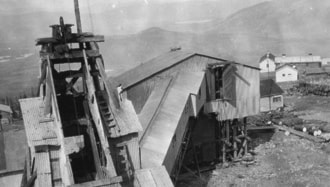Thank you to the people who wrote with information on the Wernecke Mill and camp. I hope to go up to that area this summer to sketch and photograph.
Their letters follow:
Hello Jim,
The picture of the old Yukon mill in the March 5th issue’s Can You Identify is from the Wernecke Camp located on the side of Keno Hill a few miles from Keno City, Yukon.
The camp was run by Livingston Wernecke who was general superintendent of Treadwell Yukon Mining Company.
The Wernecke camp was in operation from 1921 until 1941.
Livingston Wernecke was killed in a plane crash in October of 1941.
With his death, all Treadwell Yukon activity stopped.
The mining camp was set up to mine the large deposits of silver found in the Keno Hill area.
There were remnants of the mill infrastructure up until the 1970’s.
There are still some buildings left at the Wernecke camp, but most have collapsed over the years.
The only building that is still in relatively good shape is Wernecke’s house.
The residents of Keno City are looking at trying to preserve the manager’s house as a tribute to Wernecke and the great contribution he and his company made to the Yukon economy.
The remains of the Wernecke camp are great reminders of a very prosperous time in the silver mining history of the Keno Hill area.
Many artifacts from Wernecke camp can be seen in the Keno Mining Museum located in Keno City.
You will have to come up to see the Keno Hill area soon, Jim, as I am sure it will give you some more inspiration to compliment the wonderful artwork that you have already produced.
I will give you the grand tour!
Your friend,
Mike Mancini
The old mill in your picture was the Sadie-Ladue shaft and mill at the Wernecke Camp, about five kilometers north northeast from Keno City.
Livingston Wernecke brought the mill from Alaska-Treadwell’s Juneau properties about 1921 and it ran until 1932, when operations moved to Elsa.
Mike Phillips can identify various buildings and components of this camp.
Charlie Roots
Via website
The photo is the mill at Wernecke Camp, four miles north of Keno City.
This is the first mill built in the Yukon.
The Wernecke Camp was named after Livingston Wernecke, a mining geologist who worked for the Alaska Treadmill Company.
Wernecke arrived in Keno in June 1921 to check a claim his employers had acquired, the Gambler claim, on which the original discoverer (Louis Bouvette) had made the first 1918 float discovery on Keno Hill.
Wernecke was impressed with the area’s potential and acquired the Ledue claim.
In 1921, Wernecke hired men to build the camp and acquired a sawmill that was set up at Mayo Lake.
They began cutting lumber. Then they freighted it, along with corrugated roofing, over the trail with horses to build bunkhouses, staff houses, machine shops, a garage and other buildings.
From the Treadwell Mine at Juneau, Alaska, and from Outside, he sent mine cars, skips, hoists, steel, rails, drills, a 165-horsepower Busch-Sulzer diesel engine, a 150-kilowatt generator, electric motors, and other mine supplies.
All supplies came by sternwheelers and were then freighted to the Wernecke camp in winter by horse teams.
In May 1924, blueprints were drawn up for a 100-ton bulk floatation mill.
On January 6, 1925, the mill was completed.
In 1924, Wernecke acquired the Friendship claim near Wernecke Camp and optioned a 10-year lease from Keno Hill Mining Co. for the Sadie-Friendship portion of the Ladue vein.
At the Ladue, Wernecke wanted to build the mill at the portal of the new 600-foot level.
This would avoid hoisting and $200-a-day pumping costs.
Treadwell Yukon’s owner Fred Bradley wanted to put the mill at the Wernecke camp and leave the tunnel for drainage and mine waste.
The initial cost would be $60,000 less.
To make a profit of $1,273 a day, the mill, estimated to cost $200,000, needed ore averaging 64 ounces of silver per ton and seven per cent lead. This assumed silver remained at 60 cents an ounce and lead at six cents a pound.
The mill at the Wernecke camp processed 244,330 tons of ore from the Sadie Ladue claims that produced 12,725,633 ounces of silver, averaging 52.08 ounces per ton, 6.53 per cent lead and 4.51 per cent zinc.
The Wernecke camp grew into a settlement of frame buildings with corrugated iron roofs.
The mine and mill shut down on November 16, 1932.
With information from Dr. Aho’s book Hills and Silver.
Yvonne and Matthias
Keno
Thanks also to Christian Gill of Whitehorse who also took the time to reply.
